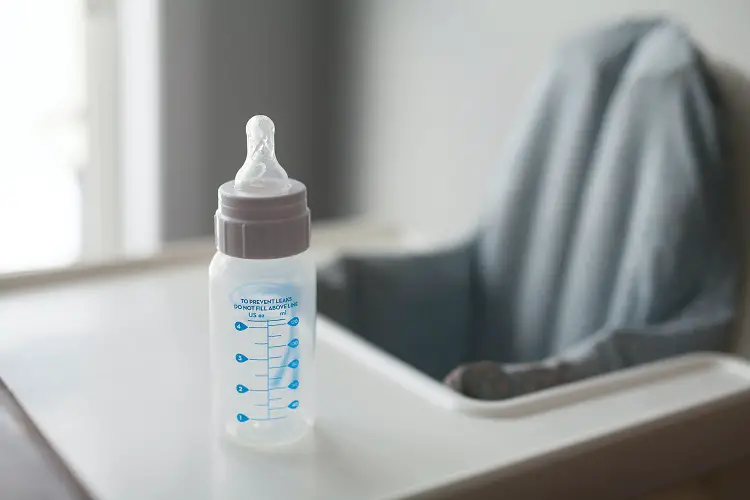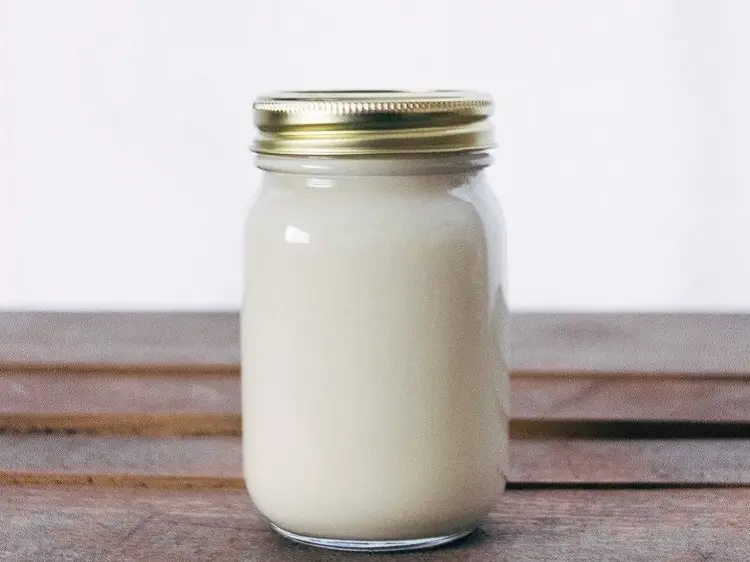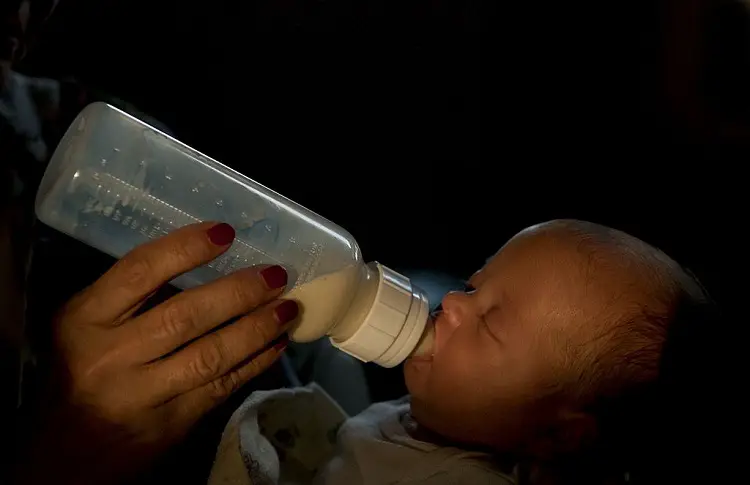Are you wondering how to store formula milk for night feeds? Are you looking for a fast and efficient way for preparing bottles for night feeds? Then you have come to the right place!
Night feeds be can tiring, and depending on your baby’s age, you’re likely to have to get up at least once in the night or sometimes you’ll be up and down like a yo-yo and as each feed can take at least 30 minutes, you’ll be missing quite a bit of precious sleeping time.
In this article, I will be sharing the methods I used to quickly prepare and also in storing bottles of formula and bottles of breast milk for night feedings.
How To Prepare Baby Bottles?
Carefully prepare your baby’s formula by mixing water and the appropriate amount of powdered infant formula. The packaging on the side of the formula container will guide you on how much to use. To prepare your baby simply follow these directions.
However, you can use tepid (room temperature) tap water, as long as your local or state health departments have labeled it as safe to drink. If you’re concerned about your water, you may sterilize it to kill germs. Here’s how you do it:
- Pour cold tap water into a teapot or saucepan.
- Place pot on the stove over medium heat.
- Bring water to a rolling boil, and let boil for about a minute.
- Let the water cool until it’s at room temperature.
- Test to see if the water is cool enough for your baby to drink by shaking a few drops of water on the inside of your wrist. If it stings, it’s still too hot.
- Once the water has cooled, don’t let it sit longer than 30 minutes before adding it to the formula.
- Once prepared, the formula is ready to feed to your baby immediately without additional refrigeration or warming.
A formula that’s been prepared should be consumed or stored in the refrigerator within 1 hour. If the formula has been at room temperature for more than 1 hour, you should discard it away.
And if your baby doesn’t drink all the formula in the bottle, throw away the unused portion do not save it for later. Also, a formula may be prepared ahead of time (for up to 24 hours) if you store it in the refrigerator to prevent the formation of bacteria.
Open containers of ready-made formula, concentrated formula, and formula prepared from concentrate also can be stored safely in the refrigerator for up to 48 hours.
Read Also: 13 Best Formulas That Taste Closest To Breast Milk
How To Prepare A Bottle Of Breast Milk For Night Feeds

As far as breast milk is concerned, there are two ways to bottle feed breast milk at night. The first is to pump right before you go to sleep. Breast milk lasts for 6 hours at room temperature.
If you know your little one will wake up in the next 6 hours, then you can use this breast milk for a night feed. The other way is by having the following supplies next to where your baby is sleeping:
- Cooler with bottles of breast milk (or bottles with a mixture of formula and breast milk).
- Bottle Warmer
- Burp Cloth
The downside to this method is it does take some time to get the milk warm enough to drink. On a side note, I always recommend that you try feeding your baby cold milk, straight from the fridge.
Read Also: 11 Newborn Night Feeding Tips To Help You Cope
Tips For Preparing Bottles For Night Feeds
Having known how to prepare both formula and breast milk bottles for night feeds, I have also compiled a summary of practical tips to help with preparing bottles for night feeds.
- Stage the supplies you need (listed above) next to where your baby is sleeping.
- Make sure you have enough bottles and milk to get you through the night (your baby might wake up more than once to eat).
- Prepare the bottles at your own pace to make sure it is done correctly. It’s easy to feel rushed with a crying baby, but if you spill milk, the whole process will be much longer.
- Have your baby sleep next to the bed until he or she is capable of sleeping in a long stretch (at least 5-6 hours). This way you can do bottle feeds without ever leaving your bed.
- Also you can invest in a feeding helper. Personally, the life-saver was my Baby Brezza Machine. It’s like a Keurig for baby bottles. It made middle-of-the-night feedings quick and easy, and it also gave me peace of mind that the family I had watching the baby at my home would use the right amount of formula and the water would be the perfect temperature.
- Finally, get a bottle warmer. If using ready-made formula or pre-making bottles that need to be refrigerated get a bottle warmer! We used the Munchkin Fast Bottle Warmer.
Read Also: 10 Bottle-Feeding Mistakes You Should Avoid
How To Store Formula Milk For Night Feeds?

While fresh formula preparation is a better option, it may not be possible for night feeds. So, you have to store it. Consider the following tips if you want to give your baby the best formula milk in the night.
- Place the formula milk in the fridge as soon as it is prepared. Ideally, it should be placed in the fridge immediately after preparation.
- Do not leave out the formula for more than an hour for avoiding bacterial growth.
- Never store the formula milk for more than 24 hours. Daily preparation is the best for night feeds.
- Store in more than one bottle to meet multiple feeding needs.
- Throw away all leftovers. Also, discard everything that crossed the 24 hours limit.
Read Also: Baby Drinks Bottle Too Fast (Tips T0 Help You Cope)
How To Warm Baby Bottles?
Some babies may prefer cold or room-temperature bottles to warm, especially if you start serving them that way from the get-go (which can make things easier for you in the long run).
But if your baby does prefer a warm bottle, remember that the microwave can create harmful “hot spots” in bottles, so it is best advised not to microwave formula.
Instead, you can:
- Run the bottle under very warm or hot water for a few minutes.
- Put your baby’s bottles in a pan of hot water.
- Use bottle warmers that either sit on your counter-top at home or plug into your car’s lighter.
Furthermore, whichever way you choose to heat your baby’s bottles, Make sure you shake the bottle vigorously. Then check the temperature of the formula by squirting a few drops on the inside or your wrist before feeding your baby. It should be lukewarm (barely warm) not hot.
Related Posts:
- Best Formula To Keep Baby Fuller Longer
- How To Make Formula Taste Like Breast Milk
- Is It Ok To Mix Breast Milk With Formula?
- How To Transition From Breast Milk To Formula
- How Long Does a Box of Formula Last? 6 Key Factors
Other Frequently Asked Questions
When Should I Prepare The Bottles?
Some parents may decide to make a bottle just before each feeding, while others may choose to pre-make and refrigerate enough to use for the day. However, if your baby eats every 3-4 hours, for instance, you can make six to eight bottles to last you all day.
If your little one is staying with a caregiver for a long period, you may want to prepare just one or two bottles and leave instructions and supplies (bottles, nipples, formula, and water, if necessary) so the caregiver can prepare bottles as required and not waste any formula.
How Long Can Mixed Formula Keep In The Fridge?
Always refrigerate any bottles you fill for later feedings to prevent bacteria from growing, as well as any open containers of ready-to-feed or concentrate formula.
Discard any mixed formula after 24 hours and any open ready-to-feed or concentrate formula after 48 hours.
How Long Can A Bottle Keep At Room Temperature?
Throw away any prepared or ready-to-feed formula that’s been sitting out after 1 hour.
If Formula Is Left Over, Can I Offer It Again?
No, throw away any leftover formula. There is a chance bacteria may have formed since the last feeding, which could make your baby sick.
Conclusion
That sums up my experience on the fastest and most effective ways to prepare bottles for night feeds, whether entirely you are feeding with formula or breast milk you need to know how to prepare formula milk for bottle feeding, and how to store formula milk for night feeds correctly.
I hope you found this post beneficial and can use these tips too. If you found this post helpful or have any suggestions, we’d love to hear in the comments section below.
